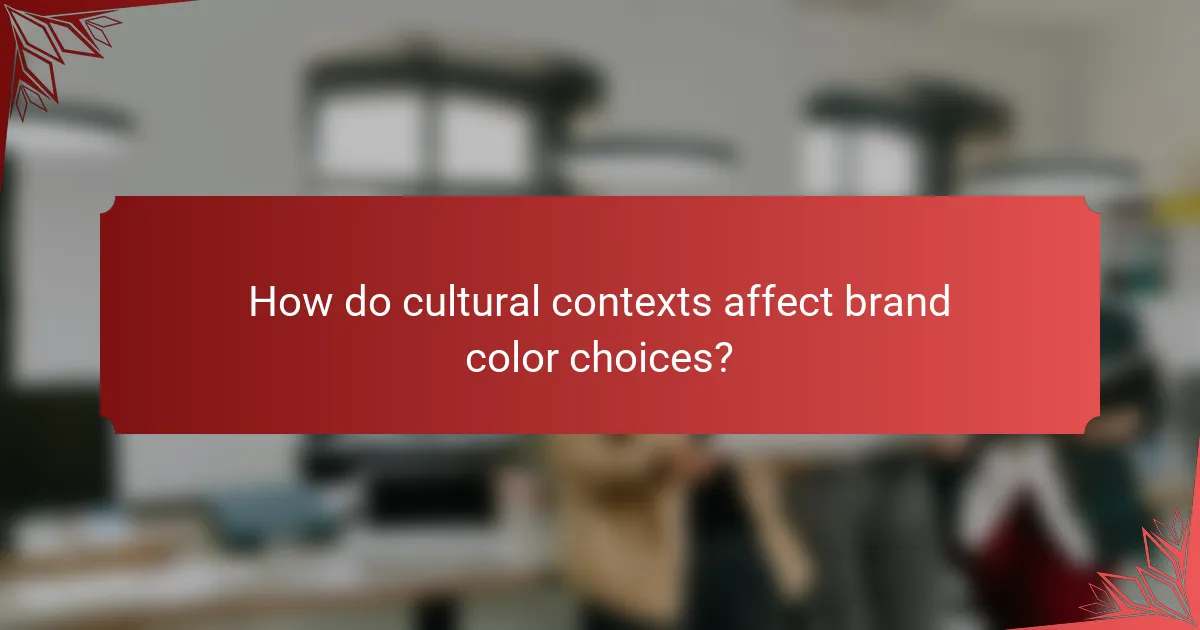Brand colors play a crucial role in shaping audience appeal and emotional impact, influencing how consumers perceive and connect with a brand. By strategically selecting colors, companies can enhance their identity, evoke specific feelings, and foster loyalty, ultimately leading to stronger brand recognition and recall.

How do brand colors influence audience appeal?
Brand colors significantly impact audience appeal by evoking emotions and creating recognition. The right color choices can enhance brand identity, influence consumer behavior, and foster loyalty.
Color psychology in marketing
Color psychology plays a crucial role in marketing by associating specific colors with particular emotions and perceptions. For instance, blue often conveys trust and reliability, making it popular among financial institutions, while red can evoke excitement and urgency, frequently used in sales promotions.
Marketers should consider the emotional responses that colors can elicit when designing their branding strategies. Understanding these associations helps brands connect with their target audience more effectively and can lead to increased engagement and sales.
Case studies of successful brands
Many successful brands have effectively utilized color to enhance their appeal. For example, Coca-Cola’s iconic red is synonymous with excitement and happiness, contributing to its global recognition and brand loyalty.
Another example is Starbucks, which uses green to symbolize growth and freshness, aligning with its brand values of sustainability and quality. These case studies illustrate how strategic color choices can reinforce brand messaging and resonate with consumers.
Demographic preferences for colors
Demographic preferences for colors can vary significantly based on age, gender, and cultural background. For instance, studies show that younger audiences may prefer vibrant colors, while older consumers often gravitate towards more muted tones.
Additionally, cultural differences can influence color perception. In some cultures, white symbolizes purity and peace, while in others, it may represent mourning. Brands should research their target demographics to tailor their color choices effectively and ensure they resonate with their audience.

What emotional impacts do brand colors have?
Brand colors significantly influence emotions and perceptions, shaping how consumers feel about a brand. The right color can evoke specific feelings, create connections, and enhance brand recognition.
Associations with specific emotions
Different colors are often associated with particular emotions. For example, blue typically conveys trust and reliability, while red can evoke excitement or urgency. Understanding these associations helps brands select colors that align with their desired emotional messaging.
Additionally, colors can have cultural implications. For instance, white symbolizes purity in many Western cultures but may represent mourning in some Eastern cultures. Brands should consider their target audience’s cultural context when choosing colors to ensure the intended emotional impact is achieved.
Impact on consumer behavior
Brand colors can significantly affect consumer behavior, influencing decisions and purchasing patterns. Research suggests that up to 90% of snap judgments about products can be based on color alone. This highlights the importance of selecting colors that resonate with the target demographic.
Moreover, consistent use of brand colors can enhance recognition and loyalty. Brands that maintain a cohesive color scheme are often more memorable, leading to increased customer retention. Therefore, businesses should strategically implement their color choices across all marketing channels to maximize impact.

How do brand colors enhance recognition?
Brand colors significantly enhance recognition by creating a visual identity that consumers can easily associate with a company. Consistent use of specific colors helps to establish brand recall and fosters emotional connections with the audience.
Importance of color consistency
Color consistency is crucial for building a strong brand identity. When a brand consistently uses the same colors across all platforms, it reinforces recognition and trust among consumers. Inconsistent color usage can confuse potential customers and dilute brand identity.
To maintain color consistency, brands should develop a style guide that outlines the exact color codes (such as HEX or RGB values) and usage guidelines. This ensures that all marketing materials, packaging, and digital assets reflect the same color scheme.
Examples of recognizable color palettes
Several brands have successfully established strong recognition through their color palettes. For instance, Coca-Cola is known for its vibrant red, while Starbucks utilizes a distinctive green. These colors are so closely associated with their respective brands that they evoke immediate recognition.
Other notable examples include McDonald’s yellow and red combination, which signifies fast food and affordability, and Tiffany & Co.’s signature robin’s egg blue, representing luxury and elegance. These color choices not only enhance brand recognition but also convey specific emotions and values associated with the brands.

What are the best practices for choosing brand colors?
Choosing brand colors involves understanding your target audience, the emotions you want to evoke, and how colors can enhance brand recognition. Effective color selection can significantly influence consumer perceptions and behaviors, making it essential to approach this process thoughtfully.
Color selection frameworks
Color selection frameworks help brands systematically choose colors that align with their values and audience preferences. Popular models include the Color Wheel, which categorizes colors into primary, secondary, and tertiary groups, and the Psychology of Color, which associates specific colors with emotions and traits. For example, blue often conveys trust and reliability, while red can evoke excitement and urgency.
When using these frameworks, consider the cultural context of your audience, as colors may have different meanings across cultures. For instance, white symbolizes purity in Western cultures but can represent mourning in some Eastern cultures. This awareness can guide your color choices to resonate positively with your target demographic.
Tools for color palette generation
There are numerous online tools available to help generate color palettes that suit your brand’s identity. Tools like Adobe Color, Coolors, and Paletton allow users to explore various color combinations and visualize how they work together. These platforms often provide options to adjust hues, saturation, and brightness, making it easier to create a cohesive look.
When selecting a tool, consider features such as the ability to save palettes, export options, and integration with design software. Additionally, some tools offer accessibility checks to ensure that color combinations are visually accessible to all users, which is crucial for inclusive branding.

How do cultural contexts affect brand color choices?
Cultural contexts significantly influence brand color choices by shaping perceptions and emotional responses. Colors can evoke different meanings and feelings across various cultures, making it essential for brands to understand these nuances to connect effectively with their target audience.
Regional color significance
Colors often carry specific meanings that vary by region. For instance, in Western cultures, white is typically associated with purity and weddings, while in some Eastern cultures, it symbolizes mourning. Brands must consider these associations to avoid miscommunication and ensure their message resonates positively.
Additionally, red is seen as a symbol of luck and prosperity in China, whereas in South Africa, it can represent mourning. Understanding these regional significances helps brands tailor their color palettes to align with local expectations and values.
Global brands adapting colors
Global brands frequently adapt their color schemes to fit different cultural contexts. For example, Coca-Cola uses red, which is universally recognized for excitement and energy, but it also respects local preferences by incorporating regional colors in marketing campaigns. This adaptability enhances brand acceptance and recognition across diverse markets.
Another example is McDonald’s, which employs green in some regions to promote freshness and health, aligning with local dietary trends. By strategically choosing colors that resonate with local audiences, brands can strengthen their emotional connection and brand loyalty.

What trends are emerging in brand color strategies?
Emerging trends in brand color strategies focus on creating emotional connections and enhancing recognition through thoughtful color choices. Brands are increasingly using colors to convey values and resonate with target audiences, adapting to cultural shifts and technological advancements.
Influence of digital media on color choices
Digital media significantly impacts brand color choices by emphasizing visibility and emotional resonance. Colors that stand out on screens, like vibrant blues and greens, are often favored for their ability to capture attention quickly. Additionally, brands are leveraging color psychology to evoke specific feelings, such as trust with blue or excitement with red.
Social media platforms also play a role, as brands often adapt their color palettes to align with trending aesthetics or user preferences. For instance, pastel colors have gained popularity for their calming effects, appealing to younger audiences on platforms like Instagram and TikTok.
Future predictions for brand colors
Future predictions suggest that brand colors will increasingly reflect sustainability and inclusivity. As consumers become more environmentally conscious, brands may adopt earthy tones and natural palettes to signify eco-friendliness. This shift can enhance brand loyalty among consumers who prioritize sustainability.
Moreover, the rise of augmented reality (AR) and virtual reality (VR) may lead brands to experiment with dynamic color schemes that change based on user interaction or context. This adaptability can create a more immersive brand experience, fostering deeper connections with audiences.

How can businesses measure the effectiveness of brand colors?
Businesses can measure the effectiveness of brand colors by analyzing their impact on customer perception, engagement, and sales. This involves assessing metrics related to brand recognition, emotional response, and overall market performance associated with specific color palettes.
Metrics for color impact assessment
Key metrics for assessing the impact of brand colors include brand recall, customer engagement rates, and conversion rates. For example, studies show that colors can influence up to 90% of a customer’s initial judgment about a product. Tracking changes in these metrics before and after a color change can provide insights into effectiveness.
Additionally, conducting surveys to gauge emotional responses to different colors can yield qualitative data. Businesses might find that certain colors evoke feelings of trust or excitement, which can directly affect purchasing decisions.
Tools for analyzing brand color performance
Several tools can help businesses analyze the performance of their brand colors. Google Analytics can track user behavior and conversion rates, while social media analytics tools can measure engagement metrics like likes, shares, and comments related to color-themed campaigns.
Color analysis software, such as Adobe Color or Coolors, allows businesses to visualize color combinations and assess their appeal. A/B testing platforms can also be employed to compare different color schemes in real-time, helping to identify which colors resonate best with the target audience.

What role do brand colors play in brand storytelling?
Brand colors are essential in brand storytelling as they evoke emotions and shape perceptions. They help create a visual identity that resonates with the target audience, influencing their connection to the brand.
Audience Appeal
Brand colors significantly impact audience appeal by aligning with the preferences and expectations of the target demographic. For instance, vibrant colors may attract younger consumers, while muted tones might appeal to a more mature audience. Understanding the cultural connotations of colors can enhance this alignment.
Consider conducting surveys or focus groups to gauge color preferences among your audience. This feedback can guide your color choices to ensure they resonate well and enhance brand affinity.
Emotional Impact
Colors can evoke specific emotions, making them powerful tools in brand storytelling. For example, blue often conveys trust and reliability, while red can evoke excitement and urgency. Selecting colors that align with the emotions you want to elicit can strengthen your brand message.
Utilize color psychology to inform your choices. For instance, if your brand aims to promote wellness, greens and soft blues may be effective in creating a calming atmosphere. Test different color palettes to see which elicits the desired emotional response from your audience.
Recognition
Brand colors enhance recognition by creating a consistent visual identity that consumers can easily identify. When used consistently across various platforms, colors help reinforce brand recall. Think of iconic brands like Coca-Cola and McDonald’s, whose colors are instantly recognizable.
To improve recognition, establish a clear color palette and apply it uniformly across all marketing materials, including websites, social media, and packaging. This consistency helps consumers associate specific colors with your brand, increasing the likelihood of recognition and recall.
